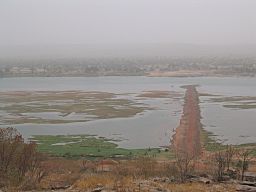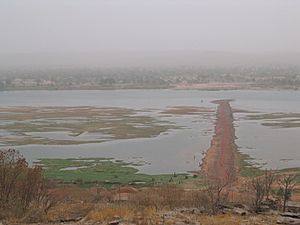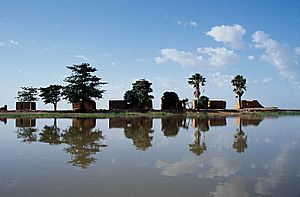Niger River facts for kids
Quick facts for kids Niger River or Fleuve Niger (Joliba, Orimiri, Isa Ber, Oya, gher n gheren) |
|
| River | |
|
The Niger at Koulikoro, Mali.
|
|
| Name origin: Unknown. Likely From Berber for River gher | |
| Countries | Guinea, Mali, Niger, Benin, Nigeria |
|---|---|
| Tributaries | |
| - left | Sokoto River, Kaduna River, Benue River |
| - right | Bani River |
| Cities | Tembakounda, Bamako, Timbuktu, Niamey, Lokoja, Onitsha |
| Source | Guinea Highlands |
| Mouth | Atlantic Ocean |
| - location | Gulf of Guinea, Nigeria |
| Length | 4,180 km (2,597 mi) |
| Basin | 2,117,700 km² (817,649 sq mi) |
| Discharge | for Niger Delta |
| - average | 5,589 m³/s (197,374 cu ft/s) |
| - max | 27,600 m³/s (974,685 cu ft/s) |
| - min | 500 m³/s (17,657 cu ft/s) |
The Niger River is a super important river in West Africa. It's more than 4,180 kilometers (about 2,500 miles) long! This makes it the third-longest river in Africa. Only the Nile and the Congo River are longer.
The Niger River has a cool crescent (moon) shape. It flows through several countries: Guinea, Mali, Niger, along the border with Benin, and then through Nigeria. Finally, it reaches the Atlantic Ocean at a huge delta called the Niger Delta. This part of the Atlantic Ocean is known as the Gulf of Guinea. The main river that flows into the Niger is the Benue River.
What's in a Name?
No one is completely sure where the name "Niger" comes from. Many people used to think it came from the Latin word niger, meaning "black." But there's no real proof for this idea. Also, the Niger River isn't a blackwater river (like the Rio Negro in South America). Plus, if Portuguese explorers had named it, they probably would have used their own word for black, which is negro.
Most experts believe the name comes from the local people who lived along the middle part of the river. Early European maps sometimes called this area "Quorra." One popular idea is that the name comes from the Tuareg phrase gher n gheren. This means "river of rivers." It might have been shortened to ngher or "niger" by people living near Timbuktu.
Ancient maps also mentioned the river. For example, the Tabula Peutingeriana called it "Flumen Girin" (River Girin). It even said some people thought it was connected to the Nile!
The countries of Nigeria and Niger are both named after this famous river. The people living along the river have many different names for it. Some call it Jeliba or Joliba, which means "great river" in the Manding language. Others call it Isa Ber ("big river" in Songhay), or Oya (named after a Yoruba river goddess). The name Kworra or Quorra was used by Europeans for the lower part of the river before they realized it was connected to the upper part.
The River's Journey
The Niger River is quite clear. It doesn't carry much sediment (like mud or sand). In fact, it has only about 10% as much sediment as the Nile! This is because the Niger starts in very old rocks that don't break down easily into silt. Just like the Nile, the Niger River has a yearly flood. This flood usually begins in September, gets strongest in November, and ends by May.
One very special part of the river is the Niger Inland Delta. This forms where the river suddenly becomes less steep. It creates a huge area of connected streams, marshes, and lakes. This area is about the same size as Belgium! The yearly floods make the delta an excellent place for fishing and farming.
The Niger River takes a very unusual path. It flows in a boomerang shape, which confused Europeans for about 2,000 years! Its source (where it begins) is only about 240 kilometers (150 miles) from the Atlantic Ocean. But instead of flowing straight to the ocean, the river flows away from the sea into the Sahara Desert. Then, near the ancient city of Timbuktu, it makes a sharp turn. From there, it flows southeast all the way to the Gulf of Guinea.
Long ago, Ancient Romans and even the famous traveler Ibn Battuta thought the river near Timbuktu was part of the Nile River. Later, in the 1600s, European explorers thought it flowed west and joined the Sénégal River. Many local people probably knew the river's true path. But Europeans only fully understood it in the late 19th century. This was thanks to the Scottish explorer Mungo Park, who wrote about it in his book Travels in the Interior of Africa.
This strange path happened because the Niger River is actually two ancient rivers that joined together. The upper part of the Niger, from its source past Timbuktu to the big bend, used to flow into a lake that has now disappeared. The lower part of the Niger started in hills near that lake and flowed south into the Gulf of Guinea. When the Sahara Desert became much drier between 4000 BC and 1000 BC, these two rivers changed their paths and connected. Most experts agree this is how the river got its unique shape.
The northern part of the river, known as the Niger bend, is very important. It's the closest big river to the Sahara Desert. Because of this, trade routes across the western Sahara often came to this area. This made it a key center for powerful Sahelian kingdoms like the Mali Empire and Gao.
Images for kids
-
Commercial activity along the river front at Boubon, in Niger
-
The great bend of the Niger River, seen from space, creates a green arc through the brown of the Sahel and Savanna. The green mass on the left is the Inner Niger Delta, and on the far left are tributaries of the Senegal River.
-
Map of the Niger, showing its watershed and "inland delta"
-
Growing African rice, Oryza glaberrima along the Niger River in Niger. The crop was first domesticated along the river.
-
A reconstruction of the Ravenna Cosmography placed on a Ptolemaic map. The River Ger is visible at bottom. Note it is placed, following Ptolemy, as just south of the land of the Garamantes, in modern Libya, constricting the continent to the land from the central Sahara north.
-
1561 map of West Africa by Girolamo Ruscelli, from Italian translation of Ptolemy's Atlas "La Geograpfia Di Claudio Tolomeo Alessandrino, Nouvamente Tradatta Di Greco in Italiano". The writer was attempting to square information gleaned from Portuguese trade along the coast with Ptolemy's world map. The mouths of the Senegal River and Gambia River are postulated to flow into a lake, which also feeds the "Ger"/"Niger River", which in turn feeds the "Nile Lake" and Nile River.
See also
 In Spanish: Río Níger para niños
In Spanish: Río Níger para niños










